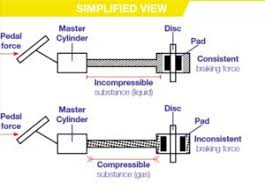The boiling point of DOT 4 brake fluid is typically around 446°F (230°C) dry and 311°F (155°C) wet.
Why Is The Boiling Point Of Brake Fluid Important?
Brake fluid is essential for your car’s braking system.
It transmits pressure from your brake pedal to the calipers, which squeeze the brake pads onto the rotors, slowing your car down.
One of the most important properties of brake fluid is its boiling point.
This is the temperature at which the fluid turns into a gas.
When brake fluid gets extremely hot, it can boil, which is called vapor lock.

Vapor lock is dangerous because it reduces the brake fluid’s ability to transmit pressure.
This means your brakes become less effective, and it can be harder to stop your car.
In severe cases, it can lead to brake failure.
However, to prevent vapor lock and ensure optimal brake performance, it’s important to maintain the correct brake fluid level and regularly replace the fluid according to your vehicle’s maintenance schedule.
Using high-quality brake fluid, such as DOT 4, with a higher boiling point can also help.
Difference Between Dry And Wet Boiling Point Of Brake Fluid
Here’s a table summarizing the key differences between dry and wet boiling points of brake fluid:
| Feature | Dry Boiling Point | Wet Boiling Point |
| Brand New Brake Fluid | Typically above 230°C (446°F) | N/A |
| Brake Fluid with Water Contamination | Lower, around 155°C (311°F) for DOT 4 | Varies depending on water content |
When you talk about brake fluid boiling point, there are actually two numbers to consider: dry boiling point and wet boiling point.
These numbers are important because they tell you how well your brake fluid can handle heat.
The dry boiling point is the temperature at which brand-new brake fluid will boil.
This number is usually pretty high.
However, real-world conditions aren’t ideal.
Over time, brake fluid can absorb moisture from the air, which is because brake fluid is hygroscopic, meaning it attracts water.
Wet boiling point is the temperature at which brake fluid will boil when it has absorbed some water.
While this number is much lower than the dry boiling point, water can really mess with your brakes.
When brake fluid gets hot enough, the water in it turns to steam.
This steam can create air bubbles in the brake lines, which can make your brakes feel spongy or even fail.
Here’s a comparison of dry and wet boiling points for common brake fluid types:
Factors like heavy driving, high temperatures, and hilly terrain can increase brake fluid temperature and accelerate water absorption.
Additional factors that can affect brake fluid boiling point include:
Brake pad material: Different brake pad materials can generate different amounts of heat, which can affect brake fluid temperature.
Brake rotor thickness: Thinner brake rotors can dissipate heat less efficiently, leading to higher brake fluid temperatures.
Vehicle weight: Heavier vehicles put more stress on the brakes, which can generate more heat.
It’s important to note that even high-quality brake fluids with high boiling points can be affected by water contamination.
That’s why it’s so important to keep your brake fluid fresh.
Regular brake fluid changes help remove water that has built up over time.
This helps maintain a high wet boiling point and keeps your brakes working as they should.
Check your brake fluid level regularly and consider having a professional inspect your brake system at least once a year.
